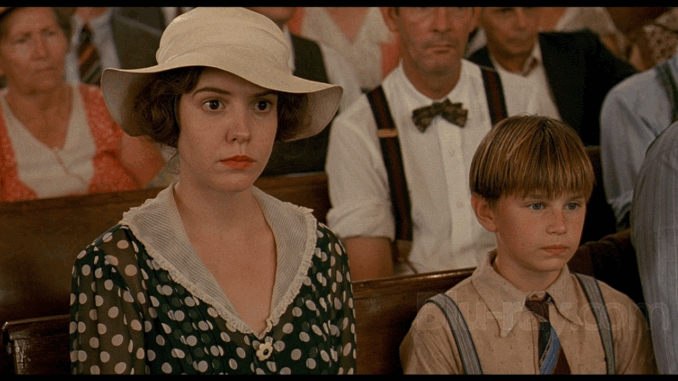
Even decades after its release, Fried Green Tomatoes continues to captivate audiences—not for the story alone, but for the incredible craftsmanship, attention to detail, and artistry that brought the world of Whistle Stop to life. From meticulously designed sets to authentic costumes, evocative music, and innovative cinematography, the film remains a masterclass in filmmaking. Here’s an in-depth look behind the camera at what made this 1991 classic so visually and technically remarkable.
Setting and Location Shooting
The film was primarily shot in Juliette, Georgia, a small Southern town transformed into the iconic Whistle Stop. The production team went to great lengths to recreate the look and atmosphere of a 1920s–1930s Southern town. Every detail—from painted storefronts and vintage signage to cobblestone streets and wooden porches—was carefully curated to create an immersive and believable setting.
The choice of Juliette wasn’t accidental. Its small-town charm, quiet streets, and authentic architecture provided a perfect backdrop that transported viewers back in time. The crew even modified local buildings, added period-appropriate props, and adjusted street layouts to ensure continuity with the era portrayed in the film. These subtle touches gave the town a timeless quality, making it feel like it existed outside of modern reality.
Costumes and Wardrobe
Equally meticulous was the film’s costume design. The wardrobe team studied historical fashion to create authentic outfits for each character. Long skirts, aprons, simple blouses, and period shoes weren’t just clothing—they were visual storytelling tools. Each costume helped define the characters’ personalities and social status while reflecting the era convincingly.
Attention to detail extended beyond major costumes. Accessories like hair ribbons, brooches, and hats were carefully chosen to maintain historical accuracy. Today, the costumes from Fried Green Tomatoes are still admired for their craftsmanship and authenticity, serving as inspiration for period-inspired fashion and costume designers alike.
Music and Sound Design
The film’s soundtrack and audio design played a crucial role in enhancing the viewing experience. Composer Thomas Newman blended light-hearted, whimsical melodies with deeper, emotional undertones. The music subtly guided viewers’ emotions, reinforcing scenes without overpowering them.
Sound effects were also carefully crafted. The sizzle of fried green tomatoes hitting a hot pan, the ambient chatter of café patrons, and the gentle rustling of leaves in the Southern breeze were all intentionally layered to create realism and charm. This attention to auditory detail helped the film feel alive, almost tactile, allowing audiences to feel present in the Whistle Stop world.
Interesting Behind-the-Scenes Facts
-
Many café scenes were filmed in a real, operational restaurant, requiring the crew to navigate around diners and work around the natural flow of the space.
-
The fried green tomatoes themselves were sometimes artificial props, specially created for long takes or complex camera angles, ensuring they maintained a perfect appearance on screen.
-
Vintage cars, bicycles, signage, and other props were sourced from collectors or carefully restored to match the 1920s–1930s Southern aesthetic. Every small detail was designed to enhance authenticity.
-
Filming often required creative solutions, such as using multiple locations to represent a single street or café, seamlessly stitched together in post-production to maintain continuity.
Cinematography and Visual Storytelling
Director Jon Avnet and cinematographer Thomas Del Ruth employed soft lighting, warm color palettes, and intimate framing to evoke nostalgia and comfort. Cameras lingered on small details—plates of steaming food, sunlight filtering through trees, or the textures of wooden floors—drawing viewers into the world visually rather than narratively.
The film’s visual style contributes significantly to its lasting appeal. The combination of careful composition, natural lighting, and thoughtful camera movement creates a cinematic experience that feels both intimate and expansive. It’s a masterclass in making the audience feel present within the world of the film, noticing details that make the setting feel lived-in and authentic.
Legacy and Continued Influence
Even today, Juliette, Georgia remains a pilgrimage site for film enthusiasts. Fans visit to see the locations, photograph the town, and experience the Whistle Stop atmosphere firsthand. Cafés, shops, and local businesses sometimes recreate aspects of the film, turning it into a living homage to the classic movie.
Beyond tourism, Fried Green Tomatoes continues to influence filmmakers, set designers, costume designers, and cinematographers. Its meticulous attention to visual storytelling, period detail, and sensory experience demonstrates how careful craftsmanship can make a film timeless, inspiring future generations to pay attention to the nuances that elevate storytelling beyond dialogue and plot.
Conclusion
Fried Green Tomatoes stands as a shining example of meticulous production design, authentic costumes, evocative music, and masterful cinematography. Even without considering its narrative or characters, the film is remarkable for the craftsmanship and attention to detail that brought an entire era to life. From carefully curated props to lighting that evokes nostalgia, every element was designed to immerse viewers in a fully realized world. Decades later, it remains a source of inspiration, proving that behind-the-scenes artistry is just as vital as the story itself in creating a cinematic classic.
